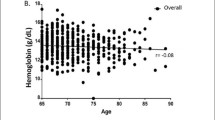Abstract
Objective
To describe the health characteristics of individuals with low HbA1c levels and evaluate the association between HbA1c level and disability or all-cause mortality in non-diabetic older adults.
Design
Prospective observational cohort study.
Setting
Seongnam, Gyeongi Province, Korea.
Participants
Among the 1,000 community-dwelling Koreans ≥ 65 years of age who were followed for 5 years, 760 non-diabetic individuals were analyzed.
Measurements
Activities of Daily Living (ADL) and Instrumental ADL (IADL) were evaluated and mortality data were obtained from the National Statistics Office of Korea.
Results
The mean age was 76.3 (SD 9.0) years, and 319 subjects (42.0%) were male. Lower level of HbA1c was associated with less frequent hypertension and less frequent use of aspirin or statin, and lower values of body mass index, hematocrit, total iron-binding capacity, albumin, and cholesterol level. The participants were categorized into 3 groups according to their HbA1c (group I, < 5.5%; group II, 5.5∼5.9%; and group III, 6.0 ∼ 6.4%). Although, there was no significant difference in functional status according to baseline HbA1c level, disability was more frequently observed as the HbA1c level decrease (18.3% in group I, 12.5% in group II, and 5.3% in group III, p=0.029) at the 5-year follow-up evaluation. There were 172 deaths (22.6%) during the follow-up period. There was no significant difference in mortality among the groups, however, group I had a 2.071-fold higher risk for the incident disability or mortality over group III after adjusting age, gender, and possible confounder (95% CI: 1.040 ∼ 4.124, p=0.038).
Conclusions
Lower level of HbA1c was associated with an increased risk of disability in non-diabetic older adults.
Similar content being viewed by others
References
Selvin E, Steffes MW, Zhu H, et al. Glycated hemoglobin, diabetes, and cardiovascular risk in nondiabetic adults. N Engl J Med 2010; 362:800–811
Emerging Risk Factors C, Di Angelantonio E, Gao P, et al. Glycated hemoglobin measurement and prediction of cardiovascular disease. JAMA 2014; 311:1225–1233
Selvin E, Ning Y, Steffes MW, et al. Glycated hemoglobin and the risk of kidney disease and retinopathy in adults with and without diabetes. Diabetes 2011; 60:298–305
Aggarwal V, Schneider AL, Selvin E. Low hemoglobin A(1c) in nondiabetic adults: an elevated risk state? Diabetes Care 2012; 35:2055–2060
Carson AP, Fox CS, McGuire DK, et al. Low hemoglobin A1c and risk of all-cause mortality among USadults without diabetes. Circ Cardiovasc Qual Outcomes 2010; 3:661–667
Inouye SK, Peduzzi PN, Robison JT, et al. Importance of functional measures in predicting mortality among older hospitalized patients. JAMA 1998; 279:1187–1193
Hayakawa T, Okamura T, Okayama A, et al. Relationship between 5-year decline in instrumental activity of daily living and accumulation of cardiovascular risk factors: NIPPON DATA90. J Atheroscler Thromb 2010; 17:64–72
Leskinen R, Laatikainen T, Peltonen M, et al. Prevalence, predictors and covariates of functional status impairment among Finnish Second World War veterans during 1992-2004. Age Ageing 2013; 42:508–514
Kalyani RR, Saudek CD, Brancati FL, et al. Association of diabetes, comorbidities, and A1C with functional disability in older adults: results from the National Health and Nutrition Examination Survey (NHANES), 1999-2006. Diabetes Care 2010; 33:1055–1060
Chin HJ, Ahn SY, Ryu J, et al. Renal function and decline in functional capacity in older adults. Age Ageing 2014; 43:833–838
Park JH, Lim S, Lim JY, et al. An overview of the Korean Longitudinal Study on Health and Aging. Psychiatry Investigation 2007; 4:84–95
Lucas DL, Brown RA, Wassef M, et al. Alcohol and the cardiovascular system: research challenges and opportunities. J Am Coll Cardiol 2005; 45:1916–1924
Won CW, Rho YG, Kim SY, et al. The Development of Korean Activities of Daily Living (K-ADL) and Korean Instrumental Activities of Daily Living (K-IADL) Scale. J Korean Geriatr Soc 2002; 6:107–120
Bowling CB, Sawyer P, Campbell RC, et al. Impact of chronic kidney disease on activities of daily living in community-dwelling older adults. J Gerontol A Biol Sci Med Sci 2011; 66:689–694
Feng L, Yap KB, Yeoh LY, et al. Kidney function and cognitive and functional decline in elderly adults: findings from the Singapore longitudinal aging study. J Am Geriatr Soc 2012; 60:1208–1214
Pani LN, Korenda L, Meigs JB, et al. Effect of aging on A1C levels in individuals without diabetes: evidence from the Framingham Offspring Study and the National Health and Nutrition Examination Survey 2001-2004. Diabetes Care 2008; 31:1991–1996
Cohen RM, Franco RS, Khera PK, et al. Red cell life span heterogeneity in hematologically normal people is sufficient to alter HbA1c. Blood 2008; 112:4284–4291
Bae JC, Suh S, Jin SM, et al. Hemoglobin A1c values are affected by hemoglobin level and gender in non-anemic Koreans. J Diabetes Investig 2014; 5:60–65
Lipska KJ, Ross JS, Wang Y, et al. National trends in UShospital admissions for hyperglycemia and hypoglycemia among Medicare beneficiaries, 1999 to 2011. JAMA Intern Med 2014; 174:1116–1124
Whitmer RA, Karter AJ, Yaffe K, et al. Hypoglycemic episodes and risk of dementia in older patients with type 2 diabetes mellitus. JAMA 2009; 301:1565–1572
Shilo S, Berezovsky S, Friedlander Y, et al. Hypoglycemia in hospitalized nondiabetic older patients. J Am Geriatr Soc 1998; 46:978–982
Boucai L, Southern WN, Zonszein J. Hypoglycemia-associated mortality is not drug-associated but linked to comorbidities. Am J Med 2011; 124:1028–1035
Aung KC, Feng L, Yap KB, et al. Serum albumin and hemoglobin are associated with physical function in community-living older persons in Singapore. J Nutr Health Aging 2011; 15:877–882
Author information
Authors and Affiliations
Corresponding author
Rights and permissions
About this article
Cite this article
Kim, KI., Kim, S., Kim, KW. et al. Low hemoglobin A1C increases the risk of disability in community-dwelling older non-diabetics adults. J Nutr Health Aging 20, 341–346 (2016). https://doi.org/10.1007/s12603-015-0583-z
Received:
Accepted:
Published:
Issue Date:
DOI: https://doi.org/10.1007/s12603-015-0583-z




